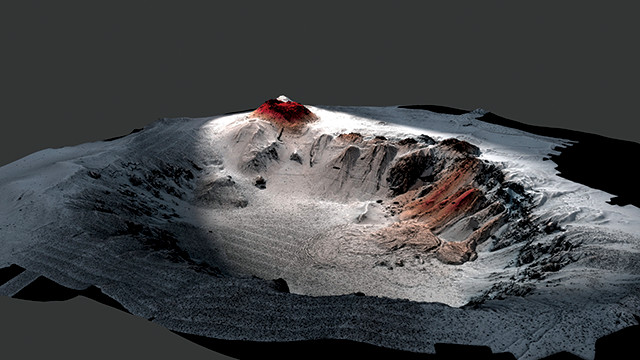
by Sarah Derouin Tuesday, April 10, 2018

Lava from the 2012 eruption of the Havre underwater volcano is shown in shades of red in this high-resolution model. Credit: University of Tasmania/Woods Hole Oceanographic Institution.
Underwater volcanic eruptions happen every day, but because of the vastness of the ocean and the great depth of water blocking the view, catching an active eruption is a game of chance. In fact, the largest-known underwater eruption of the past century was something of a fluke discovery. In July 2012, an airline passenger spotted a huge pumice raft floating in the South Pacific during a flight to Auckland, New Zealand. Upon landing, she alerted researchers, and scientists confirmed the 400-square-kilometer pumice raft near the Havre Seamount using NASA satellite imagery.
“It was pretty clear that [the pumice] originated from Havre because the satellite imagery was showing a plume coming from a point source and extending out from that point,” says Rebecca Carey, a volcanologist at the University of Tasmania in Australia and lead author of a new study in Science Advances detailing findings about the 2012 eruption. Havre, discovered in 2002, is a submarine volcano located about 1,000 kilometers north-northeast of the North Island of New Zealand.
Three years after the discovery of the pumice raft, Carey and other researchers set sail for Havre to document the eruption. The scientists launched an autonomous underwater vehicle and remotely operated vehicles to observe and sample the ocean floor around Havre. “We work on terrestrial volcanoes and so we had expectations about what we would see on the seafloor,” Carey says. “Basically, from the first observation on the seafloor, we had to throw those [assumptions] out the window.”
Observing Havre underwater revealed the complexity of the eruption, Carey says. The team found 14 volcanic vents, destabilized walls of the volcano, and a strange deposit of especially large pumice clasts up to 9 meters in diameter.
Seeing the topography allowed the team to document dispersal patterns and determine which vent was responsible for producing what lava flows, including the clasts — a feature not seen on land volcanoes. “It seems that voluminous deposits filled with these [large] pumice clasts are diagnostic of a submarine setting,” Carey says. During eruptions from volcanoes on land, magma rising to the surface can accelerate quickly with decreasing pressure, bursting into the air and fragmenting into small pieces that average about 2 millimeters across, she explains. In submarine environments, especially in deepwater, Carey says, “you have the weight of the overlying water column, so the magma ascends much more slowly” and doesn’t fragment into tiny pieces.
Another surprising realization for the team, Carey says, was that the volcanic deposits on the seafloor probably don’t tell the whole eruption story. Using the satellite-based record of the pumice raft and the detailed survey of the ocean deposits, the scientists calculated that about 80 percent of the pumice from Havre made it up into the raft and was carried away by ocean currents, much of it eventually ending up on Australian beaches in the years after the eruption. Indeed, fine material can escape the scene quickly on currents, or even through the atmosphere in shallow eruptions. “Having a quick-response cruise to observe the seafloor and deposits rapidly, before they’re altered by currents, is incredibly valuable,” says Nick Deardorff, a volcanologist at Indiana University of Pennsylvania who was not involved in the study.
This research showed that the “geologic record on the volcano edifice is really biased” because most of the material is lost to the ocean, Carey says, adding that it’s something to keep in mind when piecing together the eruption history of older volcanic deposits.
The Havre research also illuminated another important tool in studying ancient deposits, Deardorff says: those large pumice clasts can provide another way to tell an eruption above sea level from a submarine eruption. Features like these, or others, like the better-known pillow basalts, that only occur underwater or in contact with ice, can help volcanologists determine the type of eruption in ancient rocks, he adds.
Carey notes that researching active submarine volcanoes can also spur unexpected interdisciplinary discoveries. During the research cruise, for example, the team observed what an underwater eruption can do to local biological communities. “We got to the volcano three years after the eruption and virtually nothing had recolonized — it’s like a moonscape,” Carey says. “Havre provides an end-member example of the devastation” that submarine volcanoes can inflict on seafloor environments, she says.
As a result, the eruption has caught the attention of biologists and hydrothermal ecologists. Carey says another voyage back to Havre is being planned for 2020 to study recolonization and ecosystem recovery in submarine volcanic environments.
© 2008-2021. All rights reserved. Any copying, redistribution or retransmission of any of the contents of this service without the expressed written permission of the American Geosciences Institute is expressly prohibited. Click here for all copyright requests.